

Korean Culture – Guide to History, Customs, People, and Modern Day
Last modified: Jul 05, 2024 | 19 min read | By Joseph Gerocs
Are you curious about Korean culture ? Many people are since the culture in South Korea is becoming more popular all across the globe.
Perhaps you’ve heard about K-Pop , K-Dramas , Korean food , or Korean movies but don’t know much about them. Or maybe you’ve just heard a lot about South Korea in general, and you’re curious what the country is all about .
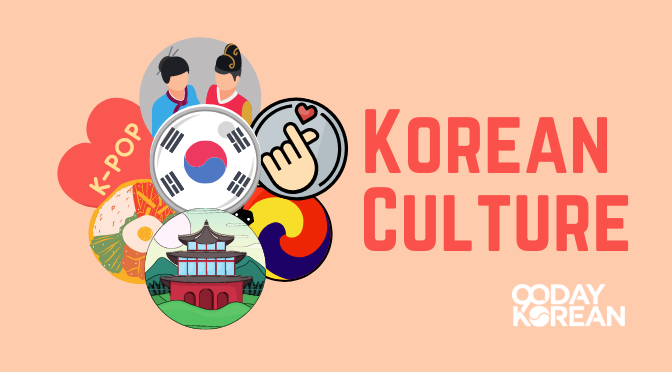
Rest assured; you’ve come to the right place! This page is chock full of everything you’ve ever wanted to know about South Korean culture .
Read on to find out more!
- 1 History of Korean Culture
- 2 Basic Facts about Korea
- 3 Korean Beliefs
- 4.1 Korean Ancestral Rites
- 4.2 Korean Burial Sites
- 5.1 Korean dance
- 5.2 Korean painting
- 5.3 Korean Pottery
- 5.4 Korean music
- 6.1 Korean cinema
- 6.2 Korean dramas
- 7.1 Korean traditional homes
- 7.2 Modern Korean House
- 7.3 Korean clothing
- 8 Korean cuisine
- 9 Korean Concept of “Face”
- 10 What is South Korean culture like?
- 11 What is the History of Korean culture?
- 12 What does the dragon mean in Korean culture?
- 13 Korean Holidays
- 14 Understanding Korean Culture
History of Korean Culture
The Korean culture is one of the oldest continuous cultures in the whole wide world. Today, starker cultural differences exist in today’s Korea, which has been split into North and South Korea. However, originally this cultural and historical heritage was shared quite identically across the entire Korean peninsula and even southern Manchuria.
Korean culture comprises all of its history, customs, traditions, and beliefs . It has been shaped by each of its different dynasties, wars, changes in religious beliefs, the modernization of the world as a whole, and many other customs and traditions that have been passed on between generations, experiencing slight changes with each generational pass. The lasting tensions between North and South Korea, which were split into their separate countries in 1945, continue to shape up both countries today.
On a perhaps more visible surface, Korean culture also consists of its food, holidays, national sports, and societal norms, as well as its popular culture in the form of music, movies, dramas, and fashion. And those are just some of the small pieces of what the culture is as a whole.
Basic Facts about Korea
The Korean peninsula, consisting of North and South Korea, is one of the most homogeneous regions in the world. Meaning that almost everyone residing in any part of the region is ethnically Korean. In South Korea, the population of Korean people is estimated to be a little over 51 million, and a little over 25 million in North Korea.
Additionally, there are around 7.4 million ethnic Koreans living all around the world. The native language is Korean, which you can read all about here . Lastly, their government type is a republic, with a president as the head of state.
Korean Beliefs
The spiritual ground and beliefs of Koreans are built mainly around the religions of Confucianism, Buddhism, and Christianity. Of these, especially Confucianism has a long record of influence in Korea, and its political and social philosophies can still clearly be seen in today’s Korea.
However, Buddhism and Christianity are also highly visible in the society where Buddhist South Koreans account for 46% of the population, and a lot of the areas in South Korea that are listed as world heritage sites are Buddhist temples.
For example, the concept of hierarchy in Korea comes from Confucianism. The hierarchy is built based on a person’s age , job status, education level, and general social rank. Thanks to Confucianism, a lot of emphases is put upon respecting one’s elders and ancestors .
And although especially the younger generations of South Koreans are becoming more and more individualistic, Korea is still a largely collective society, with the family, workplace, business, and others’ perception of you holding a lot of importance. Therefore, it is not rare to still see the type of family dynamics where the eldest son of the family holds additional responsibilities over the family. He is also expected to take care of the parents when they reach retirement age.
Korean traditions and customs
There are two major holidays in South Korea every year: Lunar New Year’s Day (설날, seollal) in January-February and Korean Thanksgiving (추석) in September-October. Both holidays are celebrated together with family, with respecting ancestors, certain holiday foods and family games playing a big part of the day. These are all part of Korean traditions and customs .
One of the most important parts of 설날 (seollal), both traditionally and today, is to perform a ritual called 세배 (sebae). In it, the whole family, dressed in 한복 | hanbok | Korean traditional dress), performs a traditional deep bow while wishing for the year to bring in a lot of luck. For food, it is normal to eat rice cake soup, savory pancakes, and stir-fried glass noodles with vegetables.
On 추석, on the other hand, it is 차례 (charye), an ancestral memorial rite, that is the most important part of the holiday. It involves a whole lot of preparation in order to create a table of offerings, and on the table will also be two candles at the edges, an incense holder in the middle, and the memorial tablet, symbolizing the spiritual presence of the ancestors, at the very center. For food, stuffed rice cakes (called 송편, songpyeon) are made as to the most traditional one, with a whole lot of others being enjoyed as well.
Korean Ancestral Rites
Koreans hold their ancestral rites for their ancestors through a memorial ceremony called 제사 (jesa) on different occasions, such as on holidays or on the death anniversary.
There are different kinds of Korean ancestral rites that are observed. They are 기제사 (gijesa), 차례 (charye), 성묘 (seongmyo), and 묘사 (myosa).
기제사 (gijesa) is held during the death anniversary of one’s ancestor. 차례 (charye) is done during the traditional holidays in Korea in each of the family’s homes to pay respect to their loved ones. 성묘 (seongmyo) is when Koreans visit the tombs of their ancestors to show love and respect to them. And finally, 묘사 (myosa) is done at the tomb site in the lunar month of October.
Korean Burial Sites
There are 2 common types of Korean burial sites where they enshrine and commemorate the remains of the deceased. One is called 묘지(myoji), which means burial ground. Cemeteries are called 공동 묘지(gongdong myoji).
The other one is called 봉안당 (bongandang), a place where the remains are enshrined after cremating the deceased. There is also 봉안담 (bongandam), which is an outdoor wall-style version of 봉안당 (bongandang).
Korean traditional arts
There are a variety of traditional arts in South Korea that can still be seen and enjoyed today. Thanks to the Korean people who are mastering these arts for many of us to enjoy. You can see them being performed in the country at special events and celebrated in exhibits around the world.
Korean dance
Based on Korean history , dances in Korea were formed as a part of shamanistic rituals an impressive five thousand years ago. Over time and the different dynasties, varieties of folk dances have evolved from these ritualistic dances. There were more than 12 types of Korean dances that were popular to perform in the court in front of royals, for example.
Some of the most popular and common traditional dances, well-known even today, are as follows:
- 탈춤 (talchum) = a dance performed while wearing a mask
- 가인전목단 (gainjeonmokdan) = a calm dance where a vase of flowers is placed at the center of the stage, and the dancers will dance around the vase, picking out flowers from the vase
- 농악 (nongak) = an energetic dance also including drums
- 부채춤 (buchaechum) = a fan dance
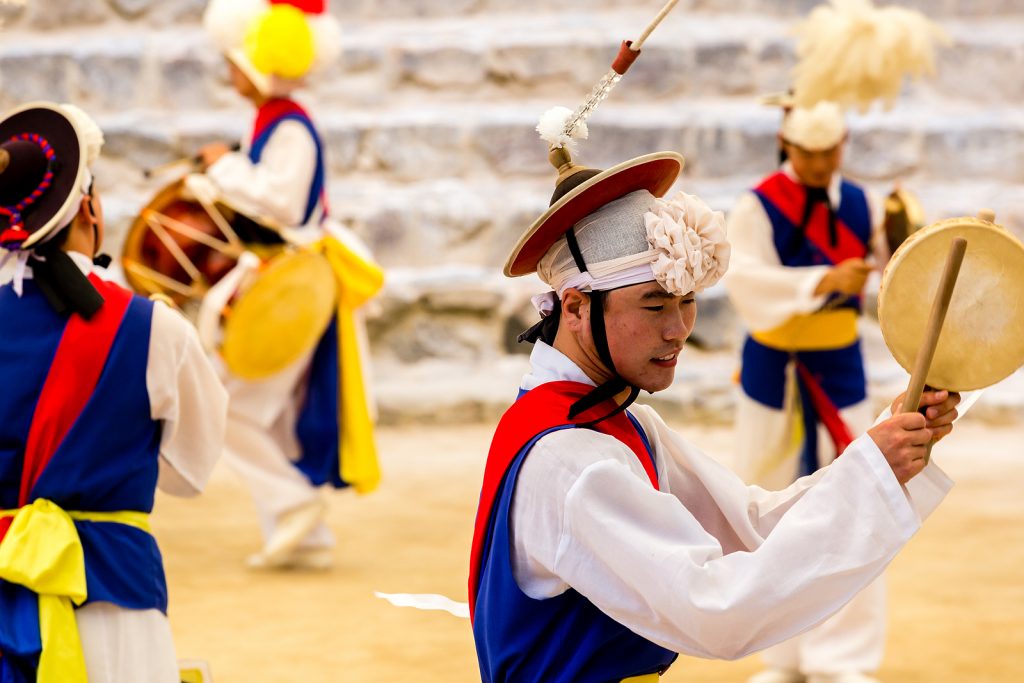
Korean painting
Painting is a type of Korean art that has been a part of Korean culture since prehistoric times. In its earliest form, Korean painting was a form of rock art, where images were created by carving out parts of a rock surface. Once Buddhism arrived in Korea, new painting techniques were introduced, quickly becoming the common and popular way to paint. This includes, for example, calligraphy .
Korean Pottery
The history of pottery and ceramics in Korea goes back thousands of years. The dominant ingredient used in Korean pottery and its style have changed over the dynasties (Goryeo dynasty to Joseon), ranging from coils and clay to pottery to porcelain. Korean ceramics have also had a strong influence on shaping Japanese ceramics.
Korean music
Besides K-pop songs , Korean music is made up of traditional Korean songs ranging from folk and court to religious. This aspect of culture comprises the music in the Korean peninsula (North and South). As a whole, this genre that is made up of traditional Korean songs is known as 국악 (gukak).
Korean Folk Music
The Korean folk song or music is typically referred to as 판소리 (pansori), which has even been designated as an intangible cultural property by UNESCO. Pansori is performed by one singer and one drummer. Some pansori songs also include dancers and/or narrators. Another type of folk music is 풍물 (pungmul), which involves drumming, singing, and dancing; it is traditionally called 농악, which has been mentioned above.
Korean Court Music
Besides folk music, Korean court music is another traditional Korean music. It was developed at the beginning of the Joseon Dynasty, getting some of its influences from Chinese court music. There are also similarities to Japanese and Vietnamese court music.
There are three types of court music. The first form is 아악 (aak), which was drawn directly from the Chinese, performed in state sacrificial rites, and still exists today as music performed in some Confucian ceremonies. The second form is 향악 (hyangak), which was created entirely by Koreans. 향악 was often accompanied by traditional country dances, with the dances being performed for an audience. The third one is 당악 (dangak), which mixes Chinese and Korean court music styles into one style. There are specific types of dances that go along with 당악.
Korean popular culture
Often referred to as “ hallyu ” or the Korean wave, the Korean popular culture is no longer only famous and popular in Korea but becoming widespread across the globe.
Korean wave mainly includes Korean pop music, dramas, and movies. In fact, although K-Pop, through acts like BTS , is a hot topic these days, it was originally Korean dramas that became famous for watching in other countries.
Korean cinema
When speaking of Korean cinema , it usually counts the time from 1945 onward. The movies take a lot of influence from Korea’s own past, featuring a lot of material from the Japanese occupation, the Korean War, the road towards democratization and globalization, and so on. Although there is still present some shyness to putting certain materials on film, simultaneously Korean filmmakers are bold in expressing their views of society through internationally well-received movies like The Handmaiden and Parasite .
Korean dramas
Korean dramas differ from a lot of Western TV content, as they are typically only made to last for one season, with one overarching plot lasting 12 to 16 or so episodes. Historical stories and sitcoms may last longer, even up to 200 episodes, but the majority of prime-time television is set up this way. The dramas range on a variety of topics, from history and action to school and work life.
However, many of the most popular dramas have had a romantic story as their main element. Love stories on screen in Korea often play out quite differently from what is common in the West, with bedroom scenes and even deep kisses still remaining relatively rare to see. In the past few years, Korean dramas have also become more interested in tackling today’s societal issues, such as classism, mental health, bullying, spy cameras, corruption, and so on.
K-Pop is short for Korean pop, Korea’s response to Western mainstream music. The music itself samples different genres, from rock and jazz to hip-hop and techno, influenced by worldwide trends.
However, despite the influences, K-Pop is also quite different from Western pop, with idol groups being its leading force. The K-pop groups are formed by entertainment agencies from hoards of young trainees, who have been signed to the agencies in hopes of debuting as an artist at a young age, often years before getting lucky. In each group, each member plays their own role: there’s a dancer, a rapper, the main singer, a pretty face, and so on.
And although the songs themselves are important, the entire concept of each “comeback” – the term used whenever a group or an artist releases new content – is carefully crafted. From hair styling to dance moves and music videos, there is often a specific theme behind each single or album release, which also influences the mood and tune of the songs.
Korean homes and clothing
As with other aspects of South Korean culture, traditional homes and clothing continue to be visible in today’s Korea, and you’ll be able to see them in your daily life in South Korea. For example, in neighborhoods like Seoul’s Gwanghwamun, it is possible to see modern Korea’s glassy high-rise buildings blend in seamlessly with historical Korea’s traditional palaces, all in one spot, complete with locals and tourists walking about wearing traditional attire.
Korean traditional homes
A traditional Korean home is called 한옥 (hanok). It was thought that they could not be built on any random spot, but the site to build the house on needs to be carefully selected. In detail, this means that the houses should be built against a hill so that they’d receive as much sunlight as possible, a way of thinking that is still shared in modern Korea as well.
These traditional houses typically comprise an inner wing and an outer wing. How these “wings” are used depends on the wealth of the family, and in general, the size of the house was also directly correlated with how rich the family was. However, even if it was the richest family in Korea, the right to the largest house was reserved for the king.
A basic design of the inner wing would include a living room and a kitchen, as well as a central hall. The richer families may have some more rooms attached to this layout. Meanwhile, the poorer families would use the outer wing for their cattle. The most common building materials were wood and clay, followed by tile, stone, and thatch. That is one large reason why so many of these houses are no longer preserved in today’s Korea.
For heating, 온돌 (ondol) was used. 온돌 means floor heating. It has been in use in Korea since prehistoric times, and it is still the main form of heating today, in modern apartments as well, typically heated up using gas.
Modern Korean House
The majority of Koreans live in a modern Korean house . And there are many types of modern Korean houses: apartments, villas, officetel or studios, service residences, and private houses.
A few common characteristics of these houses are having an area where sunshine can come in, open areas, lots of windows, and crystal doors.
Apartments are usually high-rise buildings that you’ll commonly see around the country, especially in Seoul.
Villas are low-rise buildings that typically don’t exceed 5 stories. Officetel, on the other hand, is also known as one-room. This house is inexpensive and is mostly located near subway stations.
Service residences are apartment buildings that have facilities and services similar to a hotel.
Private houses, also known as stand-alone houses, are the most expensive type of house among all the types of houses mentioned above. And you’ll not often see this type of house in urban areas.
Korean clothing
The traditional outfit in Korea is called 한복 (hanbok). It consists of a long-sleeved shirt and a long wide hemmed skirt. The specific styles and colors of each 한복 differ. Even today, it is normal for 한복s to be worn during the big holidays of 설날 and 추석. In addition to which they’re often also worn at weddings by the bride and groom’s parents, as well as the bride and groom at some point after the ceremony. Or even during the ceremony if it’s held in a traditional Korean style. It can also be worn on special events in the family, in the company, or on business events.
There were different types of 한복s in use. There was the kind used for every day, the kind for ceremonial events, and the special kind, which was usually restricted for the use of shamans, officials, and the like.
In general, clothing used to be an important mark of someone’s social rank, with people of different ranks dressing differently. Those of lower ranks typically wore plain clothes of plain colors, whereas upper classes and royals wore heavy and flashy outfits, complete with jewelry.
Korean cuisine
At the very center of Korean cuisine is rice. Korea has a long history of being nearly exclusively an agricultural country, with this having changed only recently, and you can still clearly see this in today’s cuisine. Fish and other seafood also play an integral part in shaping Korean cuisine.
Besides them, fermented dishes are largely important, kimchi being the most famous of them, rich in nutrients. The most common ingredients to use for cooking are 된장 (doenjang) which is a fermented bean paste, ginger, chili powder, fermented hot pepper paste, garlic, salt, sesame oil, and soy sauce.
In general, Koreans eat a lot of rice, vegetables , and meats. It’s typical for each meal to consist of multiple different side dishes, called 반찬 (banchan), in addition to the main course. Of them, kimchi is the staple side dish present at every meal.
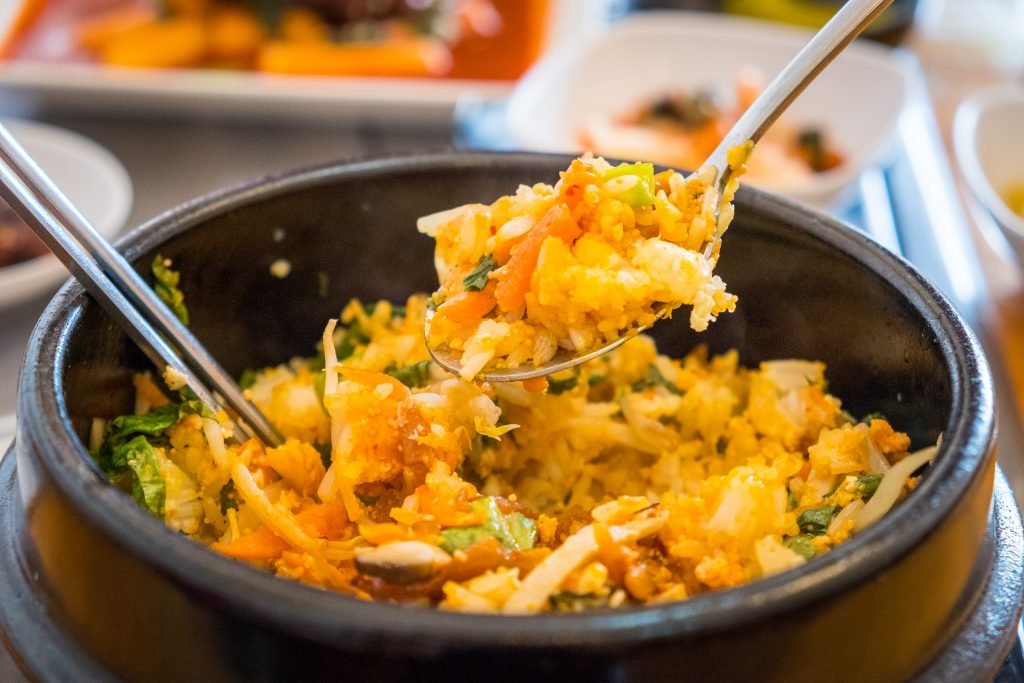
Pork is perhaps the meat eaten the most in Korea , with 삼겹살 (samgyeopsal), which is grilled pork belly, one of most Koreans’ favorite foods. Several different chicken dishes also exist, including chicken feet. Beef is seen as the meat with the highest value, which explains its comparatively higher price, although since the latter 20th century, it has become more common to eat on a regular day instead of solely on special occasions.
A lot of Korean food is served grilled, steamed, fermented, or pickled. There are also a large variety of soups and stews, as well as noodles. In addition, several specific foods, such as salty pancakes or tofu with kimchi, are commonly eaten while enjoying alcohol.
Korean Concept of “Face”
To fully understand the way of behaving and thinking of Koreans, you need to understand the concept of the face – 체면 (chaemyeon) in Korean . It is among the most integral and important things in influencing how Koreans behave in their daily life and interactions with others.
체면 (chaemyeon) in meaning translates as the appearance a person wants to – or seeks to – offer others of themselves. It is especially prevalent when it comes to one’s status in society. For example, if someone is going through hardships with a relationship, an employment situation, finances, or even something more simple as struggling to do well in school, they will want to disguise that and instead show a more poised version of themselves.
This concept is also important for interactions with interpersonal relationships. Largely because of Confucian influences, Koreans hold maintaining harmony in high regard. And therefore, all conflict with others is to be avoided, and it is even feared that it could lead to saving face. Thus, it is more sought after to keep harmony and hold in negative thoughts and emotions.
This is an age-old concept in Korea. However, due to the hardships that came from being under Japan’s rule and then the war that led to Korea being split into two, it has regained importance in Korean society.
What is South Korean culture like?
South Korea is a unique culture with influences from China , Japan , and the West. When you first come for a visit, you will notice some things that are familiar to your home country. For example, you will likely see chain restaurants and global stores that are popular back home. At the same time, you’ll notice customs, styles, and social norms that are uniquely South Korean.

What is the History of Korean culture?
Korea is one of the oldest cultures in the world. Koreans have passed down their traditions and stories for centuries. The country started to become split between North Korea and South Korea in 1945, and since then, the two Koreas have increased cultural differences.
Some of the South Korean traditional arts are ceramics, music, crafts, dance, and paintings. You can often see these displayed if you’re visiting the cultural and tourist areas of South Korea, such as 인사동 (Insadong) or 명동 (Myeongdong).
What does the dragon mean in Korean culture?
If you visit traditional buildings or look at Korean artwork , you will often see dragons. For Koreans, the dragon has a positive meaning. It symbolizes water, rain, clouds, and farming. Therefore, Korean dragons are often said to have lived in bodies of water such as oceans, rivers, and lakes. The word for dragon in Korean is 용 (yong).
Korean Holidays
South Korea shares many holidays with the rest of the world but also has some holidays unique to its culture. The most popular holidays are 추석 (Chuseok | Korean Thanksgiving) and 선랄 (Seollal | Korean Lunar New Year). During these two holidays, many Koreans return to their hometowns to visit their families.

During public holidays in Korea, most offices, banks, and government buildings are closed. However, places like museums, restaurants, cafes, amusement parks, and shopping malls remain open. The night before most public holidays, it is usually very busy in Korea with people going out to celebrate and meet friends.
There are some Korean holidays that are culturally celebrated but are not public holidays. Some examples of those are Pepero Day , Valentine’s Day , White Day , and Black Day . Koreans do not get a day off during these holidays.
| Korean Holiday | Date | Type of Holiday |
|---|---|---|
| | January 1 | Public Holiday |
| | 1st day of 1st lunar month | Public Holiday |
| | February 14 | Cultural Holiday |
| | March 1 | Public Holiday |
| | March 14 | Cultural Holiday |
| | April 14 | Cultural Holiday |
| | 8th day of 4th lunar month | Public Holiday |
| | May 5 | Public Holiday |
| | May 8 | Cultural Holiday |
| Memorial Day | June 6 | Public Holiday |
| Constitution Day | July 17 | Public Holiday |
| | August 15 | Public Holiday |
| | 15th day of 8th lunar month | Public Holiday |
| | October 3rd | Public Holiday |
| | October 9 | Public Holiday |
| | November 11 | Cultural Holiday |
| | December 25 | Public Holiday |
Understanding Korean Culture
Korean culture is truly full of history, tradition, and uniqueness. If you want to properly learn about Korea, it is important to educate yourself on its basic pillars, which you have just done by reading our article. Korea’s speedy rise from a war-ridden and undeveloped country to one of the global economy’s high hitters is one reason that allows for South Koreans, and for us, to enjoy such a blend of tradition and modernism in their culture today.
What aspect of the culture are you most excited to get to explore once you’re in Korea yourself one day: the food, the music, the history, or something else?
Related Posts
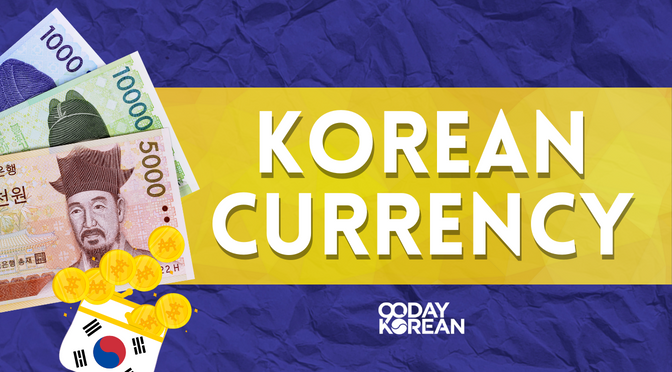
Korean Currency: All About Money, Bills, and Coins in the South
Last modified: Jul 12, 2024 | 9 min read | By 90 Day Korean
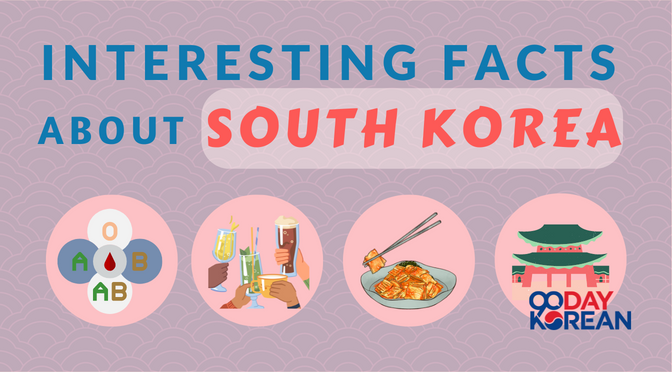
Facts About South Korea – 30 Interesting Things to Learn
Last modified: Jul 12, 2024 | 28 min read | By 90 Day Korean
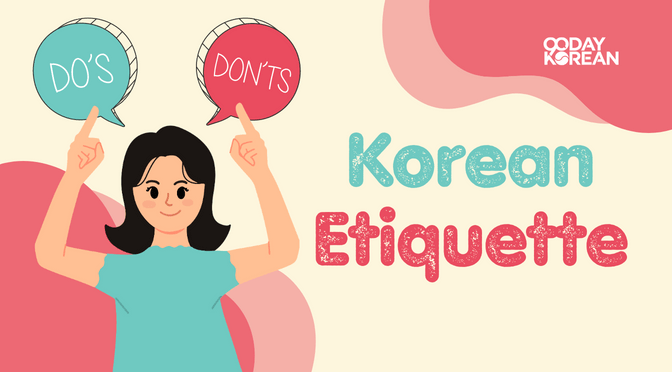
Korean Etiquette: 11 Customs You Need to Know
Last modified: Jul 12, 2024 | 11 min read | By 90 Day Korean
41 thoughts on “Korean Culture – Guide to History, Customs, People, and Modern Day”
I have been into K-pop for such a long time (probably about 7 years), now I am a senior in High School doing a research based essay on the history of Korean culture and this article was extremely helpful to me. It provided a lot of information about the history of Korea (both South and North Korea).
Awesome! Glad to hear that, Ella! ^^
Thank you for sharing information about Korea. It was amazingly informative and interesting!
It’s our pleasure, Tetyana! ^^ I appreciate your kind words! If you want to know more about the Korean language and culture, you can also check our blog and visit our YouTube channel for articles and videos with great Korean content.
ALWAYS GREAT INFORMATION…THANK YOU!
Awesome, thanks for your comment, Tim!^^ If you want more lesson on Korean, you can also check our check our blog and visit our YouTube channel for articles and videos with great Korean content.
Quite informative article. Thanks for sharing it!
Awesome, thanks for your comment! I’m glad that our article has been helpful to you. ^^ If you want more lesson on Korean, you can also check our check our blog and visit our YouTube channel for articles and videos with great Korean content.
Leave a Comment Cancel Reply
Your email address will not be published. Required fields are marked *
Choose your skill level and start getting fast results with your Korean:

Home — Essay Samples — Sociology — Race and Ethnicity — Korean
Essays on Korean
Korean essay topics for college students.
As a college student, choosing the right essay topic is crucial. It's an opportunity to explore your creativity and personal interests while demonstrating your critical thinking and writing skills. This page is designed to help you find the perfect Korean essay topic that will engage and inspire you.
Essay Types and Topics
Below, you will find a selection of diverse topics for different types of essays, including Argumentative, Compare and Contrast, Descriptive, Persuasive, and Narrative. These topics cover a wide range of subjects, from technology and society to personal growth and academic interests.
Argumentative Essay Topics
- The Influence of K-Pop on Global Culture
- The Impact of Technology on Korean Society
- Traditional vs. Modern Korean Family Values
Paragraph Example
An argumentative essay on the influence of K-Pop on global culture would begin by examining the rise of K-Pop as a global phenomenon and its impact on cultural trends worldwide. The should clearly state the central question, such as "What is the influence of K-Pop on global culture?" and present a thesis, for example, "This essay will explore the ways in which K-Pop has transformed global entertainment and fashion trends."
The influence of K-Pop on global culture has been significant, shaping fashion, music, and entertainment trends around the world. As we continue to see the influence of K-Pop grow, it is important to consider the broader implications of this cultural phenomenon.
Compare and Contrast Essay Topics
- Traditional vs. Modern Korean Cuisine
- Education Systems in South Korea vs. North Korea
- Korean Traditional vs. K-Pop Fashion Trends
Descriptive Essay Topics
- Visiting a Traditional Korean Market
- A Day in the Life of a Seoul City Resident
- The Beauty of Korean Landscapes in Different Seasons
Persuasive Essay Topics
- The Importance of Korean Language Education
- Promoting Korean Cultural Experiences for International Students
- Preserving Korean Traditional Arts and Crafts
Narrative Essay Topics
- My First Experience with Korean Culture
- An Unforgettable Trip to Jeju Island
- Learning Korean Language: Challenges and Rewards
Engagement and Creativity
As you explore these topics, remember to engage your creativity and think critically about the subject matter. Your essay is an opportunity to express your unique perspective and voice, so choose a topic that excites and inspires you.
Educational Value
Each essay type offers unique opportunities for developing different skills. Argumentative essays can enhance your analytical thinking and research skills, while persuasive essays can help you hone your ability to persuade and influence. Descriptive and narrative essays allow you to develop your descriptive abilities and storytelling techniques. Compare and contrast essays help you refine your ability to analyze and compare different subjects or ideas.
South Korean Rich Culture
My culture shock from south korean culture, made-to-order essay as fast as you need it.
Each essay is customized to cater to your unique preferences
+ experts online
Korean Food Culture
Modernization of family values in korea, south korea:opportunities and disadvantages, korean pop music (k-pop): culture, and global influence, let us write you an essay from scratch.
- 450+ experts on 30 subjects ready to help
- Custom essay delivered in as few as 3 hours
Korean Pop – a Genre that is Catching The World by Storm
The impact of korean pop music in america, traditional korean clothing - hanbok, south korea research report, get a personalized essay in under 3 hours.
Expert-written essays crafted with your exact needs in mind
The Nature of K-drama Viewership Beyond South Korea
Seven things you must check out in seoul, fast food industry in korea, highlights of seoul - must-see tourist places, south korea saunas, rapid and sustained urbanization: the korean experience and lessons for afghanistan, the military participation of canada in the korean war, analysis of why k-pop music deserves further recognition, the concept of model minority and the culture of the korean minority, politeness norm of egypt and south korea in contrast to america, jejueco: a language or dialect, the big players: international competitors and distributors in south korea, trends and fads in the 1920s, relevant topics.
- American Identity
- Cultural Identity
- Mexican American
- Physical Appearance
- African American
- Intercultural Communication
- Indigenous People
- Social Justice
- Discourse Community
By clicking “Check Writers’ Offers”, you agree to our terms of service and privacy policy . We’ll occasionally send you promo and account related email
No need to pay just yet!
We use cookies to personalyze your web-site experience. By continuing we’ll assume you board with our cookie policy .
- Instructions Followed To The Letter
- Deadlines Met At Every Stage
- Unique And Plagiarism Free
South Korean Culture
This essay about South Korean culture explores its evolution from traditional roots to its status in the modern world. It highlights the influence of Confucian values, traditional elements like the hanbok and Korean cuisine, and cultural festivals such as Chuseok. Additionally, it examines South Korea’s contemporary global influence through the Korean Wave, including K-pop and cinema. The piece illustrates the seamless integration of tradition and modernity in South Korea, emphasizing its cultural resilience and global significance.
How it works
South Korea, often called the “Land of the Morning Calm,” presents a unique blend of historical richness and contemporary vibrancy. This essay delves into the diverse elements of South Korean culture, tracing its evolution from deep-rooted traditions to its modern-day global cultural stature.
Central to South Korea’s cultural identity are its age-old traditions, underpinned by Confucian principles such as respect for elders, familial loyalty, and societal harmony. These principles are woven into the fabric of Korean life, influencing everything from family dynamics to social interactions.
The hanbok, with its beautiful colors and elegant lines, stands as a powerful symbol of Korean heritage. More than just traditional clothing, the hanbok reflects the cultural ideals of grace and humility, and its vibrant designs celebrate prosperity and good fortune.
Korean cuisine also plays a crucial role in the nation’s culture, characterized by its intense flavors and varied textures. Dishes like kimchi, which uses fermented vegetables, and bibimbap, a versatile rice dish, exemplify Korea’s agricultural heritage and the communal aspect of its food culture, where meals are a time for sharing and unity.
South Korea’s cultural calendar features numerous festivals that highlight its communal spirit and cultural legacy. Chuseok, the Korean harvest festival, symbolizes family unity and respect for ancestors with its traditional foods and folk games. Similarly, the Lunar New Year, or Seollal, is a festive time of family reunions and cultural rituals that strengthen communal ties and ensure the passage of heritage to new generations.
In the realm of modernity, South Korea is a leader in innovation and global culture. The Korean Wave, or Hallyu, has made Korean media a staple worldwide, with K-pop groups like BTS and BLACKPINK leading the charge. This musical genre mixes Korean and Western influences, showcasing South Korea’s knack for hybridization and international appeal.
Korean cinema, too, has made significant inroads globally, with films like “Parasite” by Bong Joon-ho achieving international acclaim and awards, demonstrating Korea’s capacity to produce resonant and globally relevant stories.
Modern South Korea is a place where traditional and contemporary elements intersect seamlessly. Seoul, the capital, epitomizes this blend, with historical palaces and modern skyscrapers coexisting. Traditional hanok houses, now often used as cultural centers or lodgings, epitomize the balance between preserving the old and embracing the new.
Contemporary interests such as K-beauty and e-sports thrive alongside traditional arts like tea ceremonies and taekwondo, reflecting a society that values both its history and its progression into the future.
South Korea’s culture is a dynamic mix of historical traditions and modern influences, making it a rich, vibrant tapestry that continues to evolve. As it embraces the challenges and opportunities of globalization and technological advancements, South Korea remains deeply connected to its cultural roots, showcasing a unique blend of resilience, innovation, and pride. This balance not only defines its cultural identity but also positions it as a significant player on the global stage.
Cite this page
South Korean Culture. (2024, Apr 22). Retrieved from https://papersowl.com/examples/south-korean-culture/
"South Korean Culture." PapersOwl.com , 22 Apr 2024, https://papersowl.com/examples/south-korean-culture/
PapersOwl.com. (2024). South Korean Culture . [Online]. Available at: https://papersowl.com/examples/south-korean-culture/ [Accessed: 21 Aug. 2024]
"South Korean Culture." PapersOwl.com, Apr 22, 2024. Accessed August 21, 2024. https://papersowl.com/examples/south-korean-culture/
"South Korean Culture," PapersOwl.com , 22-Apr-2024. [Online]. Available: https://papersowl.com/examples/south-korean-culture/. [Accessed: 21-Aug-2024]
PapersOwl.com. (2024). South Korean Culture . [Online]. Available at: https://papersowl.com/examples/south-korean-culture/ [Accessed: 21-Aug-2024]
Don't let plagiarism ruin your grade
Hire a writer to get a unique paper crafted to your needs.

Our writers will help you fix any mistakes and get an A+!
Please check your inbox.
You can order an original essay written according to your instructions.
Trusted by over 1 million students worldwide
1. Tell Us Your Requirements
2. Pick your perfect writer
3. Get Your Paper and Pay
Hi! I'm Amy, your personal assistant!
Don't know where to start? Give me your paper requirements and I connect you to an academic expert.
short deadlines
100% Plagiarism-Free
Certified writers
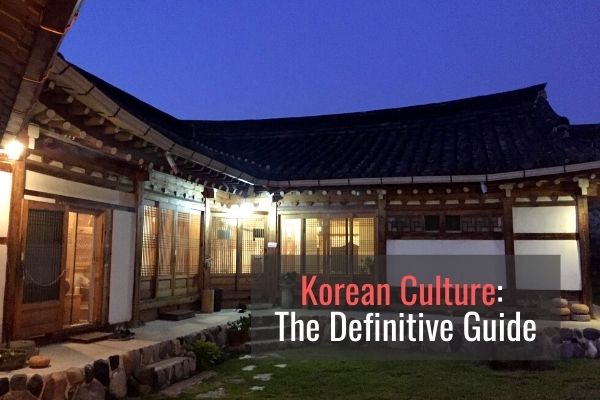
57 Interesting Things to Know about Korean Culture and Traditions
Korean culture has special birthdays, blood-type dating rules and enough drinking games to put you under the table.
This guide covers what you need to know about Korean culture and tradition .
It includes:
- Pop Culture
Most importantly, it will help you understand why Korea is the way it is.

Quick Summary
- Koreans take their shoes off before entering a home.
- It’s polite to give and receive items with two hands.
- Taekwondo, Taekkyeon, and Ssireum are Korean martial arts.
- Fermentation is a cornerstone of Korean cuisine.
Introduction
The first kingdom in Korea was founded in 2,333 BC, making it one of oldest continuous cultures in the world.
Korean culture is very distinct, partly due to its location.
Common Korean Words and Phrases you Need to Know
Like they say, geography determines destiny. Being surrounded by large and sometimes hostile neighbors influences how Koreans think to this day.
Korean culture has 4 main themes :
- Speed – Koreans skipped the whole dial up phase most countries went through and started off with fast broadband internet . Food deliveries that take more than 30 minutes are considered late. It can be contagious even for non-Koreans. After a few years in Korea I found myself jumping into a gallop with the locals when I saw a crosswalk signal turn green. I have to adjust when I go abroad or I’ll be running people over on the street.
- Competition – even before preschool, Koreans are ranked from shortest to tallest, head size and later by test scores. This only picks up steam throughout life. If you don’t believe me, try getting a seat on the subway during rush hour in Seoul.
- Appearances – looks can be everything. Not just physical, but also the clothes and makeup you wear, the car you drive and the company you work for. I was the most poorly dressed and groomed person when I first arrived in Korea. I had to adjust in order to fit in. People will treat you according to your appearance. If you look like a student, then you’ll be treated like one.
- Jeong (정) – the unspoken bond that keeps the country going. It’s formed with everyone from coworkers to the convenience store ajumma who straightens your tie in the morning. This explains why in business in Korea, contracts are more of a flexible roadmap, and the relationship is more important.
A 5,000 year mix of Shamanism, Buddhism and Confucianism, Korea has some very interesting customs.
Bowing – it’s important to greet with a slight bow at the waist, and a two-handed handshake if offered. Don’t skimp on the shaking part.
Shoes – like in most Asian countries, it’s customary to take one’s shoes off before entering a home. Koreans are especially appalled to see people wearing shoes in bed on western TV shows.
Kinship terms – Korean has fun titles for siblings and friends like unnie , hyung , oppa , noona and dongsaeng . Learning these will help you make friends.
Two hands – it’s polite to give and receive items with two hands. This is especially true when pouring drinks.
Signs of Affection – Koreans are warm people in the right setting, but public shows of affection are rare. Hugging is also not common among friends or family members and is reserved for couples. If you try to hug a friend of the opposite gender, you’ll be met with surprise at best.
Hierarchy – a remnant of confucianism, age, gender, seniority and marital status determine your position in society. In the past, there were 4 separate classes:
- Yangban (양반) – noble class who were scholars and government officials
- Jungin (중인) – middle class who were subordinates of Yangban
- Sangmin (상민) – working class including farmers that made up 75% of the population
- Cheonmin (천민) – lowest class including butchers, ditch diggers, etc.
Smiling – it’s uncommon to smile on the street for no reason, especially at people you don’t know. Smiling is reserved for loved ones and friends.
Koreans believe that, “if you see someone smiling on the street, leave”. The reason being is they’re either selling something or are a cult member.
Excusing – it’s also not necessary to say “excuse me” if a little bit of jostling occurs in public. Otherwise you’ll be saying it all day, especially in Seoul. Contrary to what your Korean textbook tells you, no one says “실례합니다”.
Baekil (백일) – celebration of 100 days. Given the aforementioned strife, infant mortality rates were high until 50 years ago. This ceremony is still important though, but more for family and tradition.
Doljabi (돌잡이) – when a child turns one year old, he/she is placed in front of a table with some objects. It’s believed that the one they pick up will determine their destiny.
Some of the common items are a thread(long life), pencil(studious), money(wealth), and stethoscope(doctor). The items can be selected according to the parent’s hopes for the child.
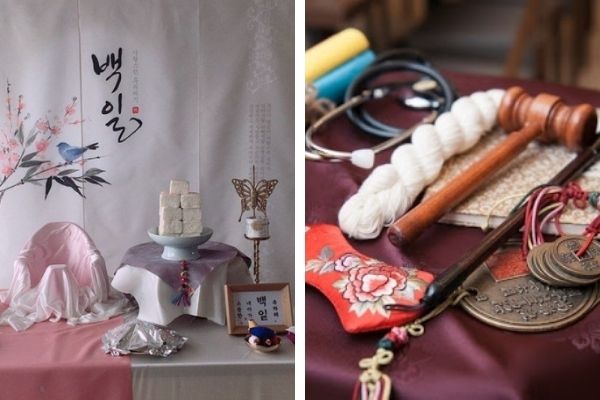
Blood type (혈액형) – Koreans believe your blood type determines your personality. For example:
- Type A are narrow-minded perfectionists
- Type B are passionate but self-centered
- Type AB can be either ambitious or crazy
- Type O are outgoing/popular but sometimes ruthless
They will be surprised if you don’t know yours.
Couple style (커플룩) – it’s not uncommon to see couples wearing the same shirt, even when they’re not on their honeymoon. I’ve even seen complete matching outfits with socks and shoes that are identical.
Regardless of your opinion on couple shirts, it’s hard not to be impressed with the effort.
Hwangap (환갑) – 60th birthday celebration. Life wasn’t easy in Korea, and making it to 60 was kind of a big deal. This celebration is still very important even though life expectancy is higher than 60.
Children are supposed to give their parents fancy gifts or a swanky dinner at a 5-star hotel.
Baek il (백일) – if you’re looking for another reason to celebrate your child’s birth, this is it. Baek-il is a party for newborns after their first 100 days!
Just like Hwangap above, it’s related to the shorter life expectancy that Korea had in the past. If a baby made it 100 days, people would throw a nice party for their family.
Weddings (결혼) – in the past, weddings lasted 3 days. But during the period of economic growth, Park Chung-hee limited them to a brief celebration to reduce waste.
Now, weddings tend to last a few hours , buffet reception included. I’ve been to ones where people left early to eat and watch the ceremony live on CCTV.
But, some traditions like hahm are still going strong. After the wedding, understanding the relationships between husbands , wives and in-laws will help you live more peacefully.
Ancestral rites (제사 or 제례) – according to traditional Korean beliefs, a person’s spirit visits their house to eat 제사상 on the anniversary of their death. The deceased are still considered part of the family for a few generations.
Funerals – a three day affair with an outpouring of emotion. A picture of the deceased is displayed in black and white and mourners come with cash envelopes and flowers.
Only immediate family stays for 3 days. Usually the firstborn son plays the role of host (상주) and wears all black while greeting visitors.
Protests – so maybe not an ancient tradition but one that seems to be catching on. It seems like there’s always one going on in Gwanghwamun (광화문) or Yeouido (여의도).
Koreans fought hard for their democracy and continue to be politically active. They impeached their previous president in a few months with peaceful protests of over 1 million people in the dead of winter.
A Complete List of South Korean Presidents and Their Accomplishments

From Pansori (판소리) to Kpop, music has been an important part of Korean life for a few millennia. Music from Baekje (백제) even influenced Japanese royal court music.
Most music before 57 BC was played with string instruments for shamanistic harvest rituals.
During the Three Kingdoms period, each region had a musical instrument they favored.
In the Goguryeo (고구려) kingdom, people would gather every night to sing and dance.
Music became more uniform in the Goryeo (고려) period after the Three Kingdoms were united. Music in the Royal Court incorporated styles from United Shilla (통일신라) into their Buddhist celebrations.
Music further evolved during Joseon (조선), especially under King Sejong (세종대왕), who even wrote a few songs himself. He also developed an independent musical notation, Jeongganbo (정간보) , for different instruments. Many songs were recorded in Akhak Gwebeom (악학궤범).
Due to Korea’s class system, music for Yangban, the noble class and music for peasants became different.
While court officials and nobles enjoyed instrumental music during ceremonies and celebrations with acrobats and performers, the public enjoyed more oral traditions like pansori, sanjo (산조) and namsadang (남사당).
Fast forward a few centuries and Kpop is a dominant force around the world. On top of its traditional Korean roots, Kpop is influenced by nearly every genre of music on the planet. They even have their own music apps .
Just like how religion influenced western art (for example, Catholic influence during the Renaissance), Korean art transitioned with the major religions of the time. This includes:
- Shamanistic art during the bronze and iron age
- Buddhist art during the Three Kingdoms and Goryeo periods
- Confucian art during Joseon
Korean art is known for its beauty from simplicity, spontaneity and harmony with nature.
Korean art dates back to 7,000 BC with pottery. Pottery and jewelry then show a Siberian influence with similar comb designs and curved beads representing bear claws.
One of the most interesting art discoveries was 7,000 year old petroglyphs (반구대 암각화) of whales, tigers, deer, turtles and other marine life carved into a cliff in Ulsan.
Art blossomed during the Three Kingdoms period with the rise of Buddhism.
Baekje was considered the kingdom with the finest art with concepts borrowed from Chinese dynasties that in turn influenced Japan. They even used a signature smile on many statues that was mysterious as the Mona Lisa’s.
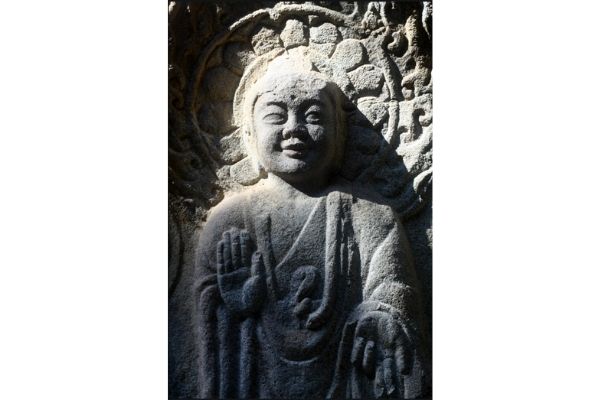
Shilla was the last kingdom to adopt Buddhism, since they were furthest away from China. They developed unique art and excelled at gold smithing.
Once Shilla unified Korea, art really took off. One of my favorite experiences was visiting Seokguram (석굴암) in Gyeongju and seeing the perfectly preserved Buddha statue in the only artificial granite cave in the world.
Pictures don’t do the experience justice and you’ll be amazed at how surreal it is.
Celadon pottery from the Goryeo period was covetted by China and considered the best in the world. It was popular for its unique blue-green “King-fisher” color and the different shapes they could blend into one piece.
With the start of the Joseon kingdom, Buddhism was out and Confucianism was in.
But that didn’t stop the Buddhist influence on art. Even though the royal court didn’t officially favor it, the public still appreciated its beautiful simplicity.
Over time, Chinese influence on Korean art fizzled out and the country underwent its own art renaissance. During this time, Korea developed a unique style of painting, which was more realistic and colorful.
During Japanese colonization and the Korean War, Lee Jung-seob created revolutionary art. Too poor to buy art supplies, he used tin foil from cigarette packages and anything else he found laying around.
He’s known for his iconic White Ox oil painting that embodies the spirit of Koreans who never give up.
There’s a popular art gallery featuring his work on Jeju Island that I highly recommend.
Calligraphy
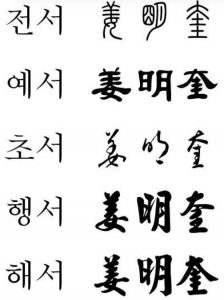
Calligraphy became a major art form in Korea after the invention of paper. Five major types of calligraphy developed over time:
- Jeonseo (전서) – real script
- Yeseo (예서) – official script
- Choseo (초서) – cursive script
- Haengseo (행서) – semi-cursive script
- Haeseo (해서) – block script
You can see the elegance in calligraphy’s simplicity and minimalism. It allows for more expression than you’d imagine, since artists show their personality through their brushstrokes.
Paper made from Mulberry roots from 751 was discovered in the 1960s, proving the old saying that “Korean paper can last 1,000 years”. Unfortunately, most paper art was destroyed during the numerous wars Korea hosted.
Poetry started to catch on during the Three Kingdoms period. It was mostly reserved for nobility. Joseon kings would play a drinking game with a cup of refined rice wine(소주 or 청주) that they’d float on a circular stream.
The object was to come up with a poem before the cup came back to them. The person who couldn’t keep up would drink.
Hyangga (향가) was developed in unified Shilla. It’s the first purely local poetry that transcribed Korean sounds in hanja(Chinese characters). It’s known for its formal rules that dictate structure, the longest of which was 10 lines.
Goryeo songs lacked clear form and tended to be longer. They were mostly oral with some recorded later during the Joseon period. Here’s a surviving example of one.
Sijo (시조) is the most notable Korean poetry style and was developed in late Goryeo but became popular in Joseon. They’re characterized by having 3 lines with 14-16 syllables.
Sijo are usually about nature, love, nostalgia, past events and moral lessons. While mostly created by yangban, Kisaeng (기생), or “female entertainers” were also allowed to write and recite Sijo.
Gasa (가사) were long poems originally sung by Yangban to show off their free time and loyalty to the king. After the development of Hangeul in late Joseon, women and peasants were able to make their own.
The themes were often related to love and nature.
It’s theorized that this form of poetry evolved into modern Korean music including Kpop.
10 Enriching Korean Art Museums in America
Martial Arts
The Korean peninsula is a geopolitical hotbed that has hosted more than a few invasions and wars. As a result, martial arts have flourished and evolved into separate disciplines.
The first recorded evidence of Martial arts in Korea was on the walls of royal tombs dating back to 1st century Goguryeo. Some of the more notable ones are:
Ssireum (씨름) – not well-known outside of Korea, it’s a form of traditional wrestling where the winner gets a cow. The object is to throw your opponent to the ground with grappling without the hitting and pushing seen in sumo.
While more of a strategy than a rule, Sirreum competitors tend to be leaner than those of sumo.
Tournament winners still get a golden cow trophy along with prize money.
Taekkyeon (택견) – billed as a sort of proto-taekwondo, the two styles have little in common. It’s more of a Korean Capoeira with throws, since the basic steps look like a dance.
Taekwondo (태권도) – literally means foot fist way, but places more emphasis on kicking. It’s a competitive sport practiced all around the world and even at the Olympics. Speed and agility are the focus.
Hapkido (합기도) – a hybrid style of martial arts with striking techniques from Korean martial arts and grappling from Japanese Judo developed after World War II.
More about fitness in Korea
MMA and Boxing – Not traditional Korean martial arts but ones that they’ve excelled at.
From the 70s to mid-90s, many word class boxers in the lower weights were from Korea.
Now, there are many Korean MMA fighters who do well in the UFC and One Championship.
Other Sports
Archery (양궁) – while archery was invented in multiple regions around the same time, Koreans dominate the sport now . It was also the main focus of warfare throughout the history of Korea.
So Ssaeum (소싸움) – think bullfighting without the bullfighter. Probably won’t be endorsed by PETA any time soon, this traditional event pits bull against bull. Fortunately, no animals are harmed in this sport as the first one to back down loses.
E-Sports (e스포츠) – took off in Korea during the 2000s with the advent of fast broadband. Koreans have helped this sport grow into the multi-million dollar industry it is today.
If you don’t believe me, play any online game at 2am against someone with hangeul in their username.
Hiking (등산) – While not exactly a sport, it’s treated that way in Korea. It’s not uncommon to see groups of hikers in matching outfits and gear dominating mountain paths.
Business Culture
Koreans have their own distinct way of doing business influenced by military hierarchy and Confucianism.
It’s important to understand the gab (갑) and eul (을) relationship and where you fit in. Here are some helpful articles on Korean business culture:
- Gifts for business visitors
- Business fashion guide
- Korean email etiquette
- Business card etiquette
- Phone etiquette
- Texting etiquette
- Important Korean statistics
The most iconic Korean outfit is Hanbok (한복). It consists of a jeogori, or blouse shirt/jacket and chima or wrap around skirt for women. Men wear a jeogori and baji or pants.
Hanbok is still worn today as formal attire for ceremonies and holidays. It’s even having a resurgence in pop culture .
From Doenjang (된장) to Soju (소주), fermentation is a cornerstone of Korean cuisine.
After traveling to 50+ countries, Korean food is still my favorite for everyday eating, since it’s healthy, filling and delicious.
Korean food is based mostly on garlic, doenjang (fermented soybean paste), gochujang(red pepper paste), and toasted sesame oil.
With these ingredients, they’re able to make a wide variety of dishes. Even after a decade in Korea, I’m still trying new things.
More about the Korean diet
Some of the more popular dishes are:
- Bulgogi (불고기)
- Samgyeopsal (삼겹살)
- Bibimbap (비빔밥)
- Naengmyeon (냉면)
- Tteokbokki (떡볶이)
- Kimchi (김치)
- Ramyun (라면)
Even though vegetarianism is only common at Buddhist temples, there are many great vegetable dishes. I was surprised at how Koreans can make vegetables taste great without using cream or butter.
Every meal comes with side dishes or banchan that can be refilled once or twice depending on the ajumma’s mood.
Those small side dishes you may have noticed at Korean restaurants or in Korean dramas. Anything in Korean cuisine besides kimchi can be considered banchan if it’s served in a small dish. They’re a great addition to daily meals and lunch boxes .
Alcohol is a big part of the dining experience.
There are over 1,000 types of alcohol for every occasion. When it rains, it’s customary to drink rice wine (막걸리) with savory Korean pancakes (전).
After a rough day, Koreans tend to drink soju. Soju goes well with raw fish (회), pork belly or soup (탕). People drink beer with fried chicken and call it chi-maek (치맥), meaning chicken and maekju (맥주).
This is common during sporting events like World Cup. Koreans even have their own fun drinking games .
Ssam is a great way to eat your veggies. It’s a method of wrapping pretty much anything in a leafy vegetable and eating it. I recommend giving it a try to add some variety to any meal.
Tea is a way of life in Korea. On top of green tea , they make it out of nearly everything including:
There’s a Korean tea for everyone and they even have health benefits.
Koreans have unique snacks that have spawned elections and black markets. They combine sweet, savory, salty and spicy into a delicate bouquet of flavors.
| 새해 첫날 (Saehae Cheotnal) | Jan. 1st | First day of the new year |
| 설날 연휴 ( ) | Dec. 31st to Jan. 2nd of the Lunar Calendar | Lunar New Years |
| 삼일절 (Samiljeol) | Mar. 1st | Independence Movement Day |
| 부처님오신날 (Bucheonim Osinnal) | Apr. 8th of the Lunar Calendar | Buddha’s Birthday |
| 어린이날 ( ) | May. 5th | Children’s Day |
| 어버이날 ( ) | May. 8th | Parent’s Day |
| 스승의 날 ( ) | May. 15th | Teacher’s Day |
| 현충일 (Hyunchungil) | Jun. 6th | Memorial Day |
| 광복절 (Gwangbokjeol) | Aug. 15th | National Liberation Day |
| 추석 연휴 (Chuseok) | Aug. 14th to 16th of the Lunar Calendar | Harvest full moon festival |
| 개천절 (Gaecheonjeol) | Oct. 3rd | National Foundation Day |
| 한글날 (Hangeulnal) | Oct. 9th | Korean Alphabet Day |
| 기독탄신일 (Gidok Tansinil) | Dec. 25th | Christmas |
Korean Year End Party (aka Friendsmas) Explained
Korean is a unique language spoken by 77 million people around the world. The linguistic family it belongs to has been disputed for many years.
For a while, Korean was included in the Altaic family along with Mongolian. Most linguists currently consider it a language isolate with no genealogical relation to others.
It now has its own family called the Koreanic family. It’s a fun language to learn with many unique expressions as well.
South Korean vs North Korean
While people from the two countries can understand each other; pronunciation, vocabulary and grammar are diverging .
Chinese characters or Hanja arrived during the Three Kingdoms period along with Buddhism. Only the elite could learn them and most of the population was illiterate.
In the 15th century, King Sejong the Great developed Hangeul, an alphabetic writing system to increase literacy. Now literacy rates are nearly 100% and one can learn how to read in an afternoon.
Words that are uniquely Korean or very useful. Konglish is mostly a combination of Korean and English words.
Onomatopoeia
Korean sounds are fun to compare with their English counterparts. Here’s a guide to Korean onomatopoeia .
The Korean language changes constantly. Here’s a guide to new Korean slang .
Modern Culture
Korean culture evolves at light speed. Here are some new trends that are uniquely Korean.
Hallyu (한류) , or the Korean Wave is a large part of modern culture. It started in the 1990’s and has helped popularize Korea around the world.
Started in 1996 with the boy band H.O.T., it’s an unstoppable force that has reached every corner of the globe.
Another driver of the Korean Wave. The first global hit was Autumn in my Heart (가을동화) in 2000, but Winter Sonata (겨울연가) took it to the next level in 2002. K-dramas are popular for their relatability, emotional connection, complete stories and attractive actors .
They’ve even started taking over Netflix with shows like Squid Game .
The Korean fashion industry is represented by male and female models who are setting trends worldwide. It comes out with versatile outfits like modern hanbok that make an impression while being comfortable.
It was only a matter of time before Koreans developed their own skincare and cosmetics . K-beauty is a newer part of the Korean wave popularized by K-pop and K-dramas.
Daum invented digital comics called “ Webtoons ” in February 2003 in light of the waning popularity of print comics and the adoption of smart phones. “Love Story” by Kang Full was the first success that popularized the industry.
Naver founded Line Webtoon in June 2004, and launched their own website on July 2, 2004. Many K-dramas are now based on the medium and are becoming increasingly popular.
Other countries including Taiwan, Mainland China, India and Southeast Asia have followed suit and have localized versions of Webtoons.
Korean Culture Abroad
From the US to the UK, Korean culture is a big hit abroad. Here are some more articles on things you can do in Koreatowns around the world.
- Sing noraebang
- Go to a spa
- Get your hair done at a Korean salon
- Play drinking games
- Explore the town
- Listen to Korean music
- Get involved in a Korean American Association
I hope you enjoyed my guide to Korean culture.
It should give you a good foundation to understand Korea.
Even after a decade living there, I’m still learning new things about their sophisticated culture.
Let us know if I missed anything in the comments!
Related Articles

How to Survive in South Korea as an Expat
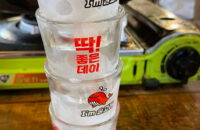
21 Korean Drinking Games for an Epic Night
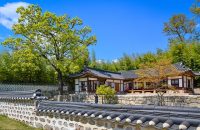
28 Interesting Ways Korean is Different From English
About the author.
Richard is a writer for Lingua Asia who has lived in South Korea for more than 10 years. While growing up, he won numerous writing awards and developed a passion for it. He has a B.A. from U.C. Irvine in Criminology, Law and Society. Richard has worked as an actor, interviewer, marketer and ESL teacher in Korea. He is fluent in Korean and is an amateur tour guide. Richard started a translation business in 2013 that he operates with his partner, Minjung. His areas of expertise are Korean language and culture, jobs for expats, Koreatowns in the USA, food, and doing business in Korea.
5 thoughts on “57 Interesting Things to Know about Korean Culture and Traditions”
Excellent article. As I enjoy the Korean series on netflix it helped me to understand more of the f there culture. Thanks a lot.
Thanks! I’m glad you enjoyed it. There’s so much to cover, it was hard to stop writing:) Which series on Netflix do you like?
Hello i am new user and i would to ask you, How to disable avatar?
Hi, not sure what you mean, but your avatar is blank now.
please dear contact me on my email ok
Leave a Comment Cancel reply
Essay Service Examples Sociology Korean
Essay about Korean Culture
- Proper editing and formatting
- Free revision, title page, and bibliography
- Flexible prices and money-back guarantee

Works Cited
- “5 Interesting Facts About Korean Food - New Shilawon Korean Restaurant 뉴신라원 - Honolulu.” NearSay, https://nearsay.com/c/419883/270561/5-interesting-facts-about-korean-food.
- “Adjusting to Korean Life - Cultural Differences When Dining Out in Korea.” Adjusting to Korean Life - Cultural Differences When Dining Out in Korea | Global Overseas Adoptees' Link, https://www.goal.or.kr/content/adjusting-korean-life-cultural-differences-when-dining-out-korea.
- “Aesthetics of Korean Foods: The Symbol of Korean Culture.” Journal of Ethnic Foods, No Longer Published by Elsevier, 14 Sept. 2016, https://www.sciencedirect.com/science/article/pii/S2352618116300853.
- Information Service. “KOREA.NET.” Food: Korea.net: The Official Website of the Republic of Korea, http://www.korea.net/AboutKorea/Korean-Life/Food.
- “Korean Cuisine.” Wikipedia, Wikimedia Foundation, 22 Sept. 2019, https://en.wikipedia.org/wiki/Korean_cuisine.
- “Korean Diet: Characteristics and Historical Background.” Journal of Ethnic Foods, No Longer Published by Elsevier, 15 Mar. 2016, https://www.sciencedirect.com/science/article/pii/S2352618116300099.
- South Korean Eating Culture - BIG BERRY - Medium. https://medium.com/bigberry/south-korean-eating-culture-sharing-is-caring-1ec1bdc282c1.
- “The Value and Meaning of the Korean Family.” Asia Society, https://asiasociety.org/education/value-and-meaning-korean-family
Our writers will provide you with an essay sample written from scratch: any topic, any deadline, any instructions.
Cite this paper
Related essay topics.
Get your paper done in as fast as 3 hours, 24/7.
Related articles
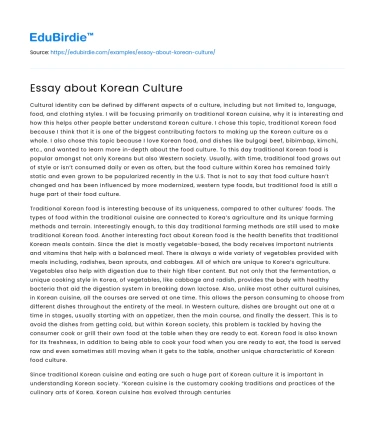
Most popular essays
The fishing industry of South Korea had been fueled by their rapid economic growth of Gross...
There are a lot of famous dramas in Japan, and many people enjoy watching them. When I was in...
In this essay, I am going to talk about the suicide problem, which is very common and serious...
In assessing the causes of the Korean War, it is of paramount importance to understand what Stalin...
- Pop Culture
Korean K-pop is very famous. As seventh chapter discuss about the music pop culture. The vital pop...
The Filipino youth were aggressively affected in the advent of the Korean craze in the...
- Plastic Surgery
After the rapid development of the Korean economy in the 1950s, people who were sharply ignorant...
Shiri, the 1999 South Korean action blockbuster changed Asian cinema forever. 20 years ago, when...
Fans of Korean dramas are familiar with the many tropes that characterize that particular genre of...
Join our 150k of happy users
- Get original paper written according to your instructions
- Save time for what matters most
Fair Use Policy
EduBirdie considers academic integrity to be the essential part of the learning process and does not support any violation of the academic standards. Should you have any questions regarding our Fair Use Policy or become aware of any violations, please do not hesitate to contact us via [email protected].
We are here 24/7 to write your paper in as fast as 3 hours.
Provide your email, and we'll send you this sample!
By providing your email, you agree to our Terms & Conditions and Privacy Policy .
Say goodbye to copy-pasting!
Get custom-crafted papers for you.
Enter your email, and we'll promptly send you the full essay. No need to copy piece by piece. It's in your inbox!

Korean Culture Facts: 40 Facts About Korean Culture You Should Know
Modern Korea is known for kimchi, k-pop, Samsung, Korean barbecue, Parasite , and more recently, Netflix hit Squid Game. But you’re grossly mistaken if you think those are the only things of interest in the Land of the Morning Calm.
The Korean peninsula has survived for over 5,000 years, bringing with it a vibrant cultural legacy comprising all forms of art, cuisine, sports, customs, and beliefs. And they’re pretty good at preserving these, too, with many heritage items being listed either as UNESCO World Heritage Sites or Intangible Cultural Heritage of Humanity.

Below are just 40 Korean culture facts. From special quirks to surprising traditions and the fascinating South Korean lifestyle, here are the most interesting things to know about Korean culture.
Table of Contents
Facts about Korean values and beliefs
1. hierarchical culture.

Confucianism has largely influenced the cultures of East Asia and in Korea, this easily manifests in the hierarchical culture.
One of the most astounding Korean culture facts is that it’s not at all strange to be asked “how old are you?” by someone you just met. This is because age, along with gender, social and economic status, is an essential factor in determining social and professional interactions
Polite language is practiced but there are several words or honorific titles that reflect this hierarchy. Sunbae, unnie, hyung, oppa, and sajangnim are just some of the terms commonly used to show respect.

2. Filial piety

Filial piety, or hyodo in Korean, is one of the most pervasive Korean traditions. Derived from the Confucianism principle of maintaining order, this is the virtue on which the traditional Korean family system is built upon.
There is an emphasis on children’s obligations, loyalty, and devotions to their parents. Children are not only required to support and serve their parents while still living with them but beyond. For the eldest son, this traditionally meant living with his parents after marriage, providing them with financial support and care.
This respect extends to the death of a parent in the form of ancestor worship. For a wife, this means subordination to her husband and her husband’s family.
3. Bowing as a sign of respect

One of the best-known Korean culture facts is the tradition of bowing.
As early as in the Three Kingdoms period (57 B.C. until A.D. 669), bowing has been practiced as part of everyday life. It is so commonplace, often done along with a quick ‘thank you’ or ‘excuse me’.
A quick, short bow of about 15 degrees or a nod of the head is often enough in most situations. Do this when greeting someone older, asking for a favor, and exchanging objects. In more formal settings like business meetings, a deeper bow may be more appropriate.
4. Giving and receiving with two hands

Korean customs dictate that one should give and receive any object using both hands. This applies to business cards, money, and gifts. Receiving items with only one hand is considered rude.
Alternatively, you may use your right hand to receive items while holding your right wrist or forearm with your left hand. This is especially applicable when shaking hands and when someone pours you a drink.
5. Shoes off

This may not be unique to South Korean culture, or even to Asian culture, but the practice of leaving one’s shoes at the door is definitely normal, and even required, in this side of the world.
Koreans have a special relationship with their floor. Thanks to their unique heating system known as ondol , traditional South Korean homes are heated through the floor. Koreans use the floor to eat, sleep, and spend their leisure time. Of course, they would want it to be clean at all times.
That’s why in any Korean home, temple, guesthouse, traditional Korean restaurants, and even in some schools, you’ll be asked to remove your shoes and wear indoor slippers or just socks.
6. Saving face

One of the most interesting Korean culture facts that may be hard for others to fathom is the culture of “saving face”. Chaemyoun (체면) or “face” is synonymous with the appearance people want to present to others in terms of their status or roles in society.
Koreans will sometimes go to great lengths to disguise their current status if they are in ‘shameful’ situations like being divorced, having bad grades, or going through unemployment. For most Koreans, showing weakness is worse than revealing the truth.
In day-to-day lives, saving face can mean letting the older or senior person pay the bill, accepting food from elders regardless of dietary restrictions, and not seeking medical help for mental health issues for fear of losing face.
7. Korean age
The concept of ‘Korean age’ is one of the most confusing South Korean culture facts.
An East Asian practice (that only Koreans practice in the modern age), Korean age dictates that the time spent in the womb is counted towards a child’s age so a baby is automatically born one year old. To make it even more confusing, everyone also gets a year older on New Year’s Day.
This means a baby born in the last week of December as one year old will turn two the following week. That’s why Koreans always have two ages – a Korean age and an ‘International Age’, or how other countries count their age.
8. Superstitions

Shamanism predates Buddhism and Christianity in Korea and despite the technological advances in the country, many Koreans still believe in superstitions today.
One common superstition is the number 4 being unlucky. You won’t see the 4th floor in the elevator and gifts in blocks of four (like four candles or four roses) are avoided. This is because the number “four” in Korean is 사 (sa), which sounds like the Chinese character for death.
Other superstitions include:
- Leaving an electric fan on while you are sleeping in a closed room can kill you.
- Writing names in red ink was considered a form of death threat.
- Dreaming of pigs is a sign that you will be rich.
- Shaking your leg restlessly can shake off the good luck coming your way.
9. Blood type

Another fascinating aspect of Korean beliefs and traditions is blood type or 혈액형 ( hyeoraekyeong ). It’s common to be asked about your blood type. And no, they’re not looking for blood donors.
Many Koreans believe that one’s blood type is indicative of his or her personality and it’s used to judge whether someone can get along with you or not, especially in potentially romantic relationships.
In case you’re wondering, Type A people are known to be responsible and caring but also anxious and perfectionistic. Type B people are outgoing, optimistic, and passionate but can be self-centered.
The best romantic match is said to be between a Type A woman and a Type O man. Type B females should avoid Type A males at all costs!
10. Couple shirts and other matching outfits

Speaking of couples, one of the cringiest Korean culture facts, at least for non-Koreans, is the practice of wearing matching outfits – same shirts, shoes, pants, or caps.
This is one form of public display of affection (PDA) that is not frowned upon. It’s also one way to show off things they’re proud of, including relationships.
Facts about the Korean Language
11. chinese vocabulary.
One of the Korean culture facts that don’t seem surprising at all, given Korea’s proximity to China, is the Chinese language’s influence on the Korean language , particularly in vocabulary.
Although the Chinese language has a completely different grammar, many of the Korean words used today have Chinese origins. This is because written historical records in Korea were maintained in classical Chinese.
Ancient Korea used Hanja, Chinese characters adapted to the Korean language, until King Sejong finally developed Hangul. That’s why even today, there are still lots of Sino-Korean words.
12. Two counting systems

One of the most mind-bending Korean culture facts for language learners is the Korean counting system.
In Korea, there are two sets of number systems and small and large numbers use different vocabulary. These two counting systems are the native Korean system and the Sino-Korean system.
The native Korean counting system is used for general counting, like counting your age, counting objects, people, hours, and more. It is also used to count up to 99.
Sino-Korean numbers, on the other hand, are used to count dates, money, minutes, distance, phone numbers, and numbers above 100.
13. Konglish

For fellow Asians, the concept of combining English with the local language is not particularly new. There’s Taglish in the Philippines, Singlish in Singapore, Manglish in Malaysia. In Korea, the Korean version of English words is known as Konglish.
Common Konglish words include:
- 아파트 (apateu) – apartment
- 사이다 (saida) – cider, but often used to refer to Sprite
- 핫도그 (hatdogeu) – corn dog
- 이벤트 (ibenteu) – event or promotion
- 머플러 (meopeulleo) – muffler or scarf
- 핸드폰 (haendeupon) – cellphone
Loanwords are also very common in the Korean vocabulary. These are words with Korean pronunciations but the same English meanings. Some examples are:
- 컴퓨터 (keompyuteo) – computer
- 포크 (pokeu) – fork
- 피자 (pija) – pizza
- 비타민 (bitamin) – vitamin
14. Differences in North and South Korean languages
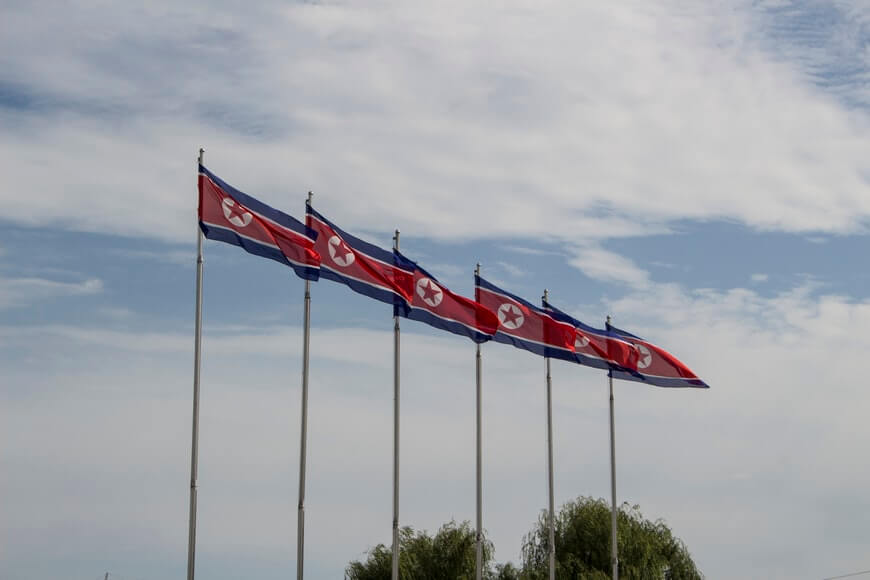
The Korean peninsula has one language called Hangugeo in South Korea and Chosonmal in North Korea. However, due to the extensive time these two countries have been separated, each language has evolved to exhibit differences in pronunciation, spelling, grammar, and vocabulary.
Standard South Korean is essentially Seoul language close to the Gyeonggi dialect while the North Korean language is derived from the Pyeongan dialect.
While South Korea uses Konglish, North Korea encourages its citizens to not use any borrowed words. If they have to, words from the Russian language are preferred. Some words are also spelled differently by the North and the South, but the pronunciations are the same.
Facts about religion in Korea
15. buddhism.

One of the most noteworthy Korean culture facts is the coexistence of many religions in the country. Korea has a variety of religions that influence Korean culture and values.
Buddhism is one of the earliest religions in Korea and one that largely affects the Korean way of life. Chinese monks introduced Mahayana Buddhism to Koreans, which became the predominant religion during the Three Kingdoms Period until the Unified Shilla time.
Interestingly, Buddhism coexisted with Shamanism at the time. Many Buddhist temples have a small chapel on the main hall, which houses shamanist deities. Today, Korean Buddhism has gained more popularity through the templestay program for travelers and those seeking retreats.
16. Confucianism
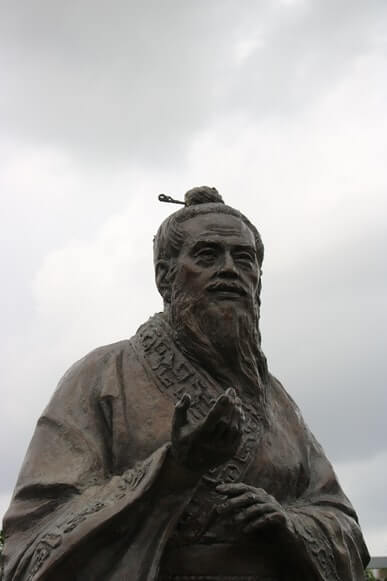
Although not a religion but a social philosophy, Confucianism has a great influence on Korean culture and traditions. It was the state religion of the Joseon dynasty and it still lives as an ethical prescription for modern Korea.
Some of the key principles and practices derived from Confucianism include ancestor worship, obedience and respect towards seniors, the value of education, the hierarchical system, family values, collectivist culture, loyalty, and modesty.
17. Shamanism and fortune telling

Shamanism is primitive religion in Korea that is occasionally practiced today. Shamanist ceremonies are sometimes held to cure illness, ward off misfortune and bad spirits, and guide a deceased family member safely into the spirit world.
Consequently, fortune telling, which is closely related to Shamanism, is still practiced. While many visit street-tent fortune tellers, some do take them seriously.
A reading of your fortune can be done through physiognomy, your time and date of birth, palm reading, or tarot cards.
Facts about Korean cuisine
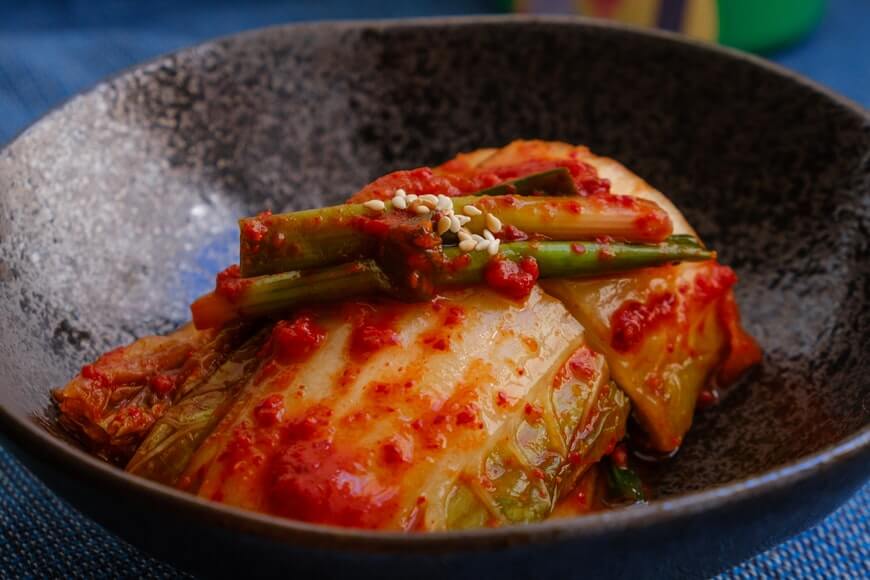
Here’s one of the most mind-blowing Korean culture facts: there are over 200 types of kimchi! This explains why this iconic Korean food is part of every meal.
And I mean, every meal. You can eat it for breakfast, lunch, dinner, or a snack.
Kimchi, for the unoriented, is a fermented dish that uses a variety of vegetables (e.g. cabbage, radishes, leeks, spring onions, etc.) and seasonings.
Depending on the fermentation process, ingredients, region, and weather, its taste changes. The fermentation process also makes it one of the healthiest foods in the world.
19. Bap (rice)

A staple food in Korea, rice or bap is always present at the dining table and comes in various forms. Ssalbap or steamed white rice is the most typically consumed.
Variations like bibimbap (steamed rice topped with seasoned vegetables, meat, and gochujang ), japgokbap (rice cooked with other grains), and kongnamulbap (rice with soybean sprout) are also common.
Furthermore, rice is also made into rice cakes ( tteok ) which are used in popular dishes like tteokbokki and injeolmi.
20. A nation of drinkers
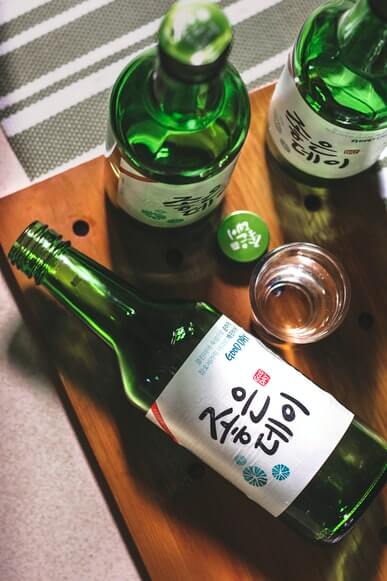
South Korean people love drinking and are known as one of the biggest alcohol drinkers in Asia . This strong drinking culture is rooted in the tradition of holidays being celebrated with food and alcohol.
The national booze is soju , a distilled liquor traditionally made from rice, wheat, or barley. This clear drink has a rather high alcohol content that varies from about 16% to 53% ABV but is loved by many.
Soju is sold everywhere at a low price and is usually enjoyed during social gatherings.
21. Low obesity rates

With a diet of healthy dishes that are rich in vegetables, fruits, and fresh seafood, it’s no wonder that Korea has one of the lowest obesity rates in the world.
In 2020, it was reported that Korea has the lowest level of obesity among OECD countries, with 4% of the adult population being obese and 30% being overweight (including obese).
However, this figure has been steadily rising. OECD projections indicate that this number will increase by 5% within the next ten years.
22. Food delivery service

Editorial credit: Ki young / Shutterstock.com
One of the unique South Korean food facts is the unmatched food delivery service. The majority of restaurants will deliver not just outside your door but anywhere, even in the middle of a public park!
But that’s not all. This efficient, organized system extends until after you eat. The delivery man will sometimes swing back later to collect the plates and containers that came with your order. Service culture FTW!
Facts about Korean entertainment and beauty standards
23. hallyu (korean wave) as cultural export.

Hallyu is a Chinese term that means ‘Korean Wave’ and it has come to define the collective growth of Korean pop culture (K-pop), TV (K-dramas and K-variety), and the movie industry.
To some degree, it also extends to Korean fashion, online games, skincare (K-beauty), and Korean cuisine (K-food).
South Korea is perhaps the only country in the world that has made it a goal to become the leading exporter of pop culture and become a soft power in the process.
The South Korean government has been providing support to creative industries since the early 1990s. This includes providing financial support to creators, policies that encourage investments, and incorporating pop culture into tourism programs.
24. K-Wave and fashion

Although Korea is known for its traditional clothing called hanbok , it is also a well-known fact that modern South Korean fashion is making a dent in the global scene, largely due to pop culture.
In modern Korean culture, being well-dressed is the norm. Known for being expressive, South Korean fashion is greatly influenced by Western culture and social media trends.
But, thanks to K-Pop and K-entertainment in general, the opposite can be said to be true, too. Now, the Western audience takes cues from Koreans when it comes to fashion. Many international brands are partnering with Korean celebrities to attract younger audiences, too.
25. Skincare and cosmetics

One of the well-known Korean culture facts is South Korea’s beauty standards. Everyone literally wants to put their best face forward.
Youthful looks, moisturized skin, and having a small face are just some of the hallmarks of beauty in South Korea. Having a skincare routine that ranges from 10 to 18 steps is pretty normal and even children are taught to put moisturizer on their skin.
This beauty standard extends to men, too. The rise of male K-pop stars with perfect good looks has pushed men to even embrace makeup and skincare. In fact, South Korean men are the world’s biggest male spenders on skincare .
26. Cosmetic surgery

South Korea has the most plastic surgeries per capita in the world. In a highly competitive culture where beauty gives you a leg up, going under the knife is accepted.
It’s estimated that as many as one in five women has undergone some sort of procedure in Seoul.
However, this isn’t some excessive remodeling. The top procedure is blepharoplasty or double eyelid surgery. Liposuction, jaw surgeries, and nose jobs are also common.
Korean holidays and celebrations
27. valentine’s day and white day.

Among the most bizarre Korean culture facts is the celebration of Valentine’s Day in South Korea. Contrary to how many cultures celebrate this holiday, in Korea, men are the ones who receive gifts and pampering.
In South Korean culture, women buy chocolates and other gifts for their male partners. Women would have to wait a whole month for men to return the favor in a holiday called ‘White Day’.
Celebrated every March 14, it’s essentially another Valentine’s Day but this time, men give gifts to women. These gifts typically include candy, chocolate, snacks, or other types of gifts that girls like.
28. Couples at Christmas, families at New Year

While most people worldwide celebrate Christmas with their families and New Year’s Eve with friends or partners, Koreans do it differently.
Christmas Day is treated as another holiday for couples in Korea. Although many people do celebrate Christmas with their families, it’s not critical and if they’re in a relationship, they will likely spend it with their significant others.
New Year’s Day or January 1, while still celebrated, is not as huge as the Lunar New Year or Seollal , which typically falls on either January or February. Before Seollal, many Koreans travel to their hometowns to visit their families.
29. Doljabi

A baby’s first birthday, locally called dol or doljanchi, is a very important affair in Korea. This is because Korea had a history of having high death rates among children, with many children dying before their first birthday.
One of the quirkiest Korean culture facts is the fortune telling ritual called doljabi . In this ritual, the baby is placed in front of various objects such as books, pens, money, stethoscope, thread, and so on. The baby is encouraged to pick an object from the selection. Whatever he or she picks will foretell his or her future.
For example, a child who picks money will grow to be wealthy. A pencil means the baby is destined to be smart. A stethoscope means he or she will be a doctor or nurse.
Definitely a strange practice but it’s one of the most enduring Korean culture and traditions.
30. Gifting toilet paper

If you ever find yourself moving houses in South Korea, don’t bother buying toilet paper because you’ll surely receive some.
One of the most practical traditions in South Korea is giving a load of toilet paper as housewarming gifts. Not only is it practical, but it also has a deeper meaning behind it.
For Koreans, cleaning supplies signify luck and good fortune to the receiver who just moved into a new home. Just as toilet paper unrolls or unravels, the gift-giver also wishes for the unraveling of success and good health in the new home.
Facts about sports in Korea
31. martial arts.

Koreans are sport-loving people. Sports, especially martial arts, is a surviving Korean heritage that is not only a means of physical improvement and self-defense but also a form of recreation.
Taekkyeon is one of the oldest martial arts in Korea. It includes fluid hands and feet techniques to unbalance, trip, or throw the opponent. It was the first martial art to be listed as an Intangible Cultural Heritage of Humanity.
But the most popular type of martial arts in Korea is taekwondo, which uses kicks, blocks, throws, takedowns, and grappling. In 2002, it was officially adopted as an Olympic sport, the only Korean martial art to have this recognition.
32. Olympic Games

Speaking of Olympics, one of the Korean culture facts that make Koreans proud is the country’s participation in Olympic Games.
South Korea first participated at the Olympics in 1948 and has sent athletes to every Summer Olympics and Winter Olympics since then, except in 1952 and 1980. It has also hosted two Olympic Games – the 1988 Summer Olympics in Seoul and the 2018 Winter Olympics in Pyeongchang.
South Korea’s performance at the Olympic Games is also stellar, ranking 18th on the combined (Summer and Winter) list of countries with the most medals. It has a total of 357 medals, with the most number of medals in judo, archery, and short track speed skating.
33. Famous athletes

Koreans love sports and they love their sports stars. The most famous athletes in Korea are treated like gods, with loyal fan bases that rival that of a K-pop star’s.
Some of the top sportspersons Korea has produced have made it on a global scale, too.
These include Choo Shin Soo who formerly played for Texas Rangers, Son Heung-min of Tottenham Hotspur, Ryu Hyun Jin of Toronto Blue Jays (previously played for Los Angeles Dodgers), former Los Angeles Dodgers pitcher Park Chan Ho, Olympic gold medalist Kim Yuna, and former Manchester United midfielder Park Jisung
34. e-Sports mecca

Modern Korea loves traditional Korean sports. But they also love virtual games. In fact, it’s no secret that South Korea is the birthplace of competitive video games known as e-Sports.
The online gaming culture in South Korea developed at a faster pace than anywhere else in the world. This is largely due to the introduction of high-speed internet in the late 90s and the proliferation of 24-hour PC bangs or gaming cafés (more on this later).
While in other countries, video games may be seen as mere hobbies, e-Sports in Korea are now run like a professional sports franchise league. It helps that there is support from the government; the Korea e-Sports Association (KeSPA) was created to manage e-Sports.
KeSPA is now a member of the National Olympic Committee of South Korea and has built the world’s first e-Sports stadium in 2005 in Yongsan. And by 2022, e-Sports will be part of the Asian Games.
More interesting facts about Korean culture
35. highly educated nation.

One of the most impressive Korean culture facts is the country’s education rate. South Korea is one of the most educa ted countries in the world , which is seen as one of the reasons for its remarkable economic success.
87.6% of adults aged 25-64 have completed upper secondary education, higher than the OECD average of 78%. It’s also the top-performing OECD country in reading literacy, maths, and sciences with the average student scoring 519, above the OECD average of 486.
Of course, this high regard for education isn’t without cost. Korea is also known for having a merciless education system. Students typically spend a total of 12 to 16 hours at school and at after-school academies called hagwons in preparation for suneung.
Suneung is the Korean word for the College Scholastic Ability Test (CSAT), a standardized eight-hour exam that determines which university a student can attend and his or her future career opportunities. This hypercompetitive test is the most stressful time in a student’s life.
36. Voice phishing

Here’s one saddening Korean culture fact: voice phishing is one the greatest threats in modern Korean culture.
Voice phishing, sometimes referred to as ‘vishing’, is a criminal practice that takes advantage of the telephone system to steal someone’s personal and financial information and as a result, steal money from that person.
This criminal phone fraud extends to messenger phishing. Text or voice messages offering attractive loans or asking for a small amount of money are the common tactics used by phishers.
In 2018, 334 billion won were generated from 54,973 cases of voice phishing . This number is seen to increase further as massive crackdowns are only able to arrest low-level managers or phone operators.
37. Korean bang culture

Bang means ‘room’ in the Korean language. But when used as a suffix, it specifically refers to a private room with a dedicated function, often related to entertainment.
A PC bang (PC 방) is an internet café. A noraebang (노래방) is the term for Korean karaoke rooms, private booths where you can sing all you want. Can’t visit an actual golf course? Try a screen golf bang (스크린골프방) and whack the ball at a screen.
Is the Korean winter chill too much for you? Head to a jjimjilbang (찜질방) or Korean bathhouse and sauna. Whatever form of entertainment or leisure you seek, there’s a high chance that there’s a bang for it.
38. Fast internet connection

One of the well-known Korean culture facts is the country’s high-speed internet connection. South Korea is a wired country and has consistently topped the list of countries with the fastest internet speeds.
It doesn’t matter where you are, whether at an internet café or an actual café, fast and cheap broadband and WiFi connections are everywhere.
Not only does Korea have the fastest internet speed. It was also the first country to have 5G network access across the country!
39. Plastic cash

Not only is South Korea one of the most wired nations. It’s also one of the countries that use less cash and more credit cards.
You’d be hard-pressed to find a place in Korea that doesn’t accept credit cards. Thanks to the pricing benefits it offers, credit card is the preferred payment method in the country. In 2020, the average frequency of credit card usage was 136.2 times – much higher than developed countries like the US, the UK, France, and Canada.
Debit card usage is also high. People use cards to pay for food delivery, restaurants, taxis, movies, shopping, and more.
40. Still at war

We conclude this list of Korean culture facts with a sobering one: the North and South are still at war.
It’s easy to forget it as you walk the streets of Seoul or as you watch K-dramas from the comforts of your home. But the two Koreas are technically still at war as no peace treaty was ever signed.
The combat ended in 1953 when the Korean Armistice Agreement was signed, creating the Korean Demilitarized Zone (DMZ) in a truce that separated the North from the South.
In 2018, the leaders of both countries met for the first time in over a decade, agreeing to conduct peace talks to formally end the conflict but these talks have been stalled.
And that caps off our list of Korean culture facts! If the traditions of South Korea fascinated you and you want to continue learning all about Korea, we recommend these interesting reads:
- 30 Things South Korea is Known and Famous For
- 25 Books About Korea to Add to Your Reading List
- 40 Interesting Facts About Korean Cuisine
Fun and interesting Korean culture facts – Pin it!

Leave a Comment Cancel reply
Save my name, email, and website in this browser for the next time I comment.

© 2024 Hey Explorer
Stock images by Depositphotos
- Entertainment
- Environment
- Information Science and Technology
- Social Issues
Home Essay Samples Sociology
Essay Samples on Korean
Exploring why k-pop and korean wave is so popular.
Intro Hello everyone. Today I will be discussing how the integration of social media into Kpop fandoms, particularly through video streaming platforms like Youtube, has affected fan participatory culture, by altering the interaction and behaviours of fandoms and the distribution of Korean content throughout the...
- Music Industry
Taekwondo: Korean Art of Defending Yourself and Your Loved Ones
Taekwondo is a Korean martial art, characterized by its emphasis on head-height kicks, jumping and spinning kicks, and fast kicking techniques. The name Taekwondo means the way of the foot and fist. Various martial artists combined the elements of Karate and Chinese martial arts with...
The Impending Danger of the Korean War and Desire for Peace
Wars have rarely been the solution to prejudices in the history of mankind. Yet wars have always been fought ruthlessly to quench the human desire of domination and power. The obsession to enforce one’s own ideology, and the need to prevail and survive have led...
The Influence of Political Parties on the Development of Korean Culture and Society
In this essay, I will address some of the underlying assumptions of the question posed in order to reframe it into a more nuanced inquiry that relates Korea’s cultural and societal development to the influence of nearby powerful political entities. I will first challenge the...
Portrayal and Depiction of Women in the Korean Literature Influenced by the Korean War
My topic is focus on females in Korean literatures. Korean female's literature is deeply influenced by patriarchy. From the rise of Korean modern novels in the 1920s to the 1990s, Korean female's literature mostly represented females' subordination of the patriarchalism. This subordination is reflected in...
Stressed out with your paper?
Consider using writing assistance:
- 100% unique papers
- 3 hrs deadline option
Effects of Patronizing Korean Pop (KPOP) Songs in the Philippine Music Industry
Abstract Philippine music, with its famous OPM and other genres of music brought by the influence of the westerners, have been affected when foreign music like Korean pop songs became famous to the Filipinos. It has been affected in a sense that only a few...
The Importance to Appreciate Korean Culture in the Medical Field
In the medical field, there are many different cultures, religions that you are going to run into that face different beliefs, backgrounds that you may not understand. One example is the Korean culture. Even though a majority of Korean people understand and speak English you...
- Alternative Medicine
- Cultural Anthropology
The International Profit and Dependancy of the Korean War
The major downfall of the European and American forces is that they underestimated the Asian forces, and the willingness of China to fight in protection of its interests. They saw the Koreans as an inferior people, and this prejudice led them to believe that they...
- International Politics
The Pattern of Korean Migration to Philippines
Looking at it from a national-level perspective, Kutsumi (2004), studies the formation of social organization and offers some estimates of the magnitude of Korean migration to the whole of the Philippines. Using data obtained from the Annual Report of Statistics on Immigration and Emigration Control...
- Philippines
Comparing And Contrasting Cultures: Korean Culture And Caribbean Hispanics
I find the Korean culture very interesting because my favorite food to eat is Korean bbq and I would love to learn more about their culture. According to statistics, the international diabetes federation lists the prevalence of diabetes in Korea in 2003 as 5% to...
Destination Image Of Ho Chi Minh City By Korean Tourists
During the past few decades, destination image (DI) has been extensively defined in literature from a psychological perspective. In the tourism literature, destination image has been defined by a range of specific keywords, as mental impressions, knowledge, beliefs, expectations, ideas, perceptions, and emotional thoughts of...
My Tour Of The Korean DMZ
The Korean DMZ is a 2.5-mile wide border that spans the 160-mile long peninsula between North and South Korea. Leading up to WWII, the Japanese controlled the Korean peninsula. Later, the area was predominantly communist with hopes of expanding throughout the entire area. However, that...
The Crucial Aspects Of South Korean Business
Introduction As the international affairs officer for Fontana Technologies, I was tasked with the responsibility of determining what country would be best suited for our 2019 expansion. After analyzing a number of socioeconomic components, South Korea is the location that compliments the needs as well...
- Microeconomics
Best topics on Korean
1. Exploring Why K-pop And Korean Wave Is So Popular
2. Taekwondo: Korean Art of Defending Yourself and Your Loved Ones
3. The Impending Danger of the Korean War and Desire for Peace
4. The Influence of Political Parties on the Development of Korean Culture and Society
5. Portrayal and Depiction of Women in the Korean Literature Influenced by the Korean War
6. Effects of Patronizing Korean Pop (KPOP) Songs in the Philippine Music Industry
7. The Importance to Appreciate Korean Culture in the Medical Field
8. The International Profit and Dependancy of the Korean War
9. The Pattern of Korean Migration to Philippines
10. Comparing And Contrasting Cultures: Korean Culture And Caribbean Hispanics
11. Destination Image Of Ho Chi Minh City By Korean Tourists
12. My Tour Of The Korean DMZ
13. The Crucial Aspects Of South Korean Business
- Social Media
- Gender Stereotypes
- National Honor Society
- Gender Roles
- Body Language
- Social Observation Report
- Uncertainty Reduction Theory
- Anthropology
Need writing help?
You can always rely on us no matter what type of paper you need
*No hidden charges
100% Unique Essays
Absolutely Confidential
Money Back Guarantee
By clicking “Send Essay”, you agree to our Terms of service and Privacy statement. We will occasionally send you account related emails
You can also get a UNIQUE essay on this or any other topic
Thank you! We’ll contact you as soon as possible.

Essay on South Korea
Students are often asked to write an essay on South Korea in their schools and colleges. And if you’re also looking for the same, we have created 100-word, 250-word, and 500-word essays on the topic.
Let’s take a look…
100 Words Essay on South Korea
Introduction.
South Korea, officially known as the Republic of Korea, is a country in East Asia. It’s known for its green, hilly countryside, centuries-old Buddhist temples, and high-tech cities.
South Korea is located on the southern part of the Korean Peninsula. It is surrounded by the Yellow Sea to the west, and the East Sea to the east.
Capital City
The capital city, Seoul, is a bustling metropolis with modern skyscrapers, high-tech subways, and pop culture alongside historic palaces, and street markets.
Korean culture is rich with tradition, including the popular Korean music, K-pop, and Korean dramas that are famous worldwide.
250 Words Essay on South Korea
South Korea, officially known as the Republic of Korea, is a country in East Asia, constituting the southern part of the Korean Peninsula. Its rapid economic growth, technological advancements, and rich cultural heritage make it a fascinating subject of study.
Economic Growth and Technological Advancements
South Korea’s economic growth, often referred to as the “Miracle on the Han River,” transformed it from a war-torn nation to an economic powerhouse. It is home to renowned multinational corporations like Samsung, Hyundai, and LG. Moreover, the country’s technological advancements, particularly in the fields of IT and robotics, have positioned it as a global leader in innovation.
Culture and Heritage
South Korea’s rich cultural heritage, embodied in its traditional music, dance, and art forms, coexists with its modern pop culture. The global phenomenon of K-pop and Korean dramas (K-dramas) has significantly increased its cultural influence, a phenomenon known as the “Korean Wave” or “Hallyu.”
Political Landscape
The political landscape of South Korea is marked by its democratic system and ongoing tensions with North Korea. Despite these challenges, South Korea has maintained political stability, contributing to its economic and social progress.
South Korea’s journey from devastation to prosperity, its technological prowess, and cultural richness offer valuable insights into the transformative power of innovation, cultural preservation, and resilience. It stands as a testament to the potential of human endeavor in shaping a nation’s destiny.
500 Words Essay on South Korea
Economic development.
South Korea’s economic narrative is one of the most compelling stories of the 20th century. From the ashes of the Korean War, the nation rose to become the 10th largest economy in the world, a phenomenon often referred to as the “Miracle on the Han River.” South Korea’s economic model, heavily reliant on chaebols (family-controlled conglomerates), has been instrumental in this rapid development. Companies like Samsung, Hyundai, and LG have become global powerhouses, contributing significantly to the country’s GDP.
Technological Advancement
South Korea is a global leader in technological innovation and digital connectivity. With the highest internet speed in the world and a tech-savvy population, the nation is at the forefront of the Fourth Industrial Revolution. South Korea’s commitment to research and development, coupled with a robust education system, has fostered an environment conducive to technological advancement. The country is also home to the city of Songdo, one of the world’s first smart cities designed from the ground up.
Cultural Exportation
Despite its economic and cultural prowess, South Korea faces a complex and challenging political landscape. The nation is technically still at war with North Korea, as the Korean War ended with an armistice, not a peace treaty. This geopolitical tension, coupled with the pressure of being sandwiched between China and Japan, presents unique challenges for South Korea.
South Korea is a nation that has successfully navigated the path from war-torn poverty to economic prosperity and global cultural influence. Despite the geopolitical tensions that persist, the country continues to forge ahead, driven by innovation, cultural richness, and an indomitable spirit. South Korea’s journey is a testament to the power of resilience, strategic planning, and cultural vibrancy. It serves as an example for other nations aspiring to similar heights of development and global impact.
Apart from these, you can look at all the essays by clicking here .
Happy studying!
Leave a Reply Cancel reply
Home / Essay Samples / Sociology / Race and Ethnicity / Korean
Korean Essay Examples
Behind the idol life: the dark side of music in south korea.
Korean idol group SHINee, debuted in 2008. When they debuted, in only a matter of months they already had 60 award wins and 86 nominations, plus 57 music show wins. They have managed to stay relevant for many years. Some of the members of the...
South Korea’s Culture Through Entertainment
Korea is more mountains than anything else, none over 10,000 feet. The Koreans have one of the oldest culture in the world. According to the legends and myths concerning the origin of Koreans, the oldest and most often cited is the Tangun/Dangun. The legend says...
The Stages of Korea's History & Its Relations with Other Countries
Since the history of Korea goes back through hundreds of years before the division, the facts and description are chosen selectively and briefly. The history of Korea goes through several stages that have constructed what we now call Korea, before the division the nation’s foundation...
Analysis and Review of the Documentary South Korea: the Silent Cultural Superpower
British Broadcast Company (BBC) is known for its string of documentaries on various phenomena, and its documentary on South Korea “South Korea: The Silent Cultural Superpower” quietly becoming a cultural superpower is one that has informed and enthralled its viewers as much as any other....
The Rising Idols: Analysis of Btc Album
The artifact I have chosen is the Korean pop album, The Most Beautiful Moment In Life, Part 2, by the South Korean group, BTS (Bangtan Sonyeondan). This album was released in 2015 and received overwhelming support from domestic and international fans around the globe. This...
My International Engagement and Friendship
When I turned ten, I moved from South Korea, a predominantly monoracial country to Singapore, one of the most multiracial countries in the world. It was a struggle to adapt to an environment so different from my own but I was presented with an endless...
Trying to find an excellent essay sample but no results?
Don’t waste your time and get a professional writer to help!
You may also like
- Social Justice
- American Dream
- Discourse Community
- American Identity
- Nonverbal Communication
- First Impression
- Media Analysis
- Citizenship Essays
- Cultural Diversity Essays
- Racial Profiling Essays
- Native American Essays
- Cultural Relativism Essays
- Chinese Essays
- German Essays
- Mexican Essays
- African American Essays
- Equality Essays
samplius.com uses cookies to offer you the best service possible.By continuing we’ll assume you board with our cookie policy .--> -->